
We were in the home
stretch now ... but instead of heading directly to our last scheduled
destination, Firenze, why not go by way of Pisa? And see more of Tuscany
in the process? Great idea, and Peter went along (actually he was driving,
so I went along). [Toscana
slide show]
![]() We
went through some not-so-nice areas on our way into Pisa from the south
(it had to happen at some point). Pisa itself was quite large and congested.
After several missed turns, heading the wrong way on one-way streets,
and backtracking, we got to where we could park and walk to Piazza del
Duomo (yet another one), also called Campo dei Miracoli. It was a long,
horizontal, grassy plaza with three elegant buildings: the Battistero,
the Duomo, and the Torre pendente (Leaning tower). We didn't go inside
any — the tower was closed, of course, and the other two had admission
charges. [Pisa
slide show]
We
went through some not-so-nice areas on our way into Pisa from the south
(it had to happen at some point). Pisa itself was quite large and congested.
After several missed turns, heading the wrong way on one-way streets,
and backtracking, we got to where we could park and walk to Piazza del
Duomo (yet another one), also called Campo dei Miracoli. It was a long,
horizontal, grassy plaza with three elegant buildings: the Battistero,
the Duomo, and the Torre pendente (Leaning tower). We didn't go inside
any — the tower was closed, of course, and the other two had admission
charges. [Pisa
slide show]
It was interesting to learn about the amazing engineering project, almost completed, to stabilize the Tower. After years of political debate the work began in 1990 after warnings that the tower could collapse (not fall over). The alluvial soil had been giving way under its weight for centuries. The base was stablilized by removing soil from the high side, so the tower would right itself somewhat. In the process all sorts of stabilizing techniques were used to protect the structure. I can't explain it too well, but here they do. Just a month after our visit, the Tower was reopened (with limited public access).
In northern Tuscany,
there was a different look to the land. The gentle green hills were gone,
replaced by larger, darker mountains and wider valleys. In Florence there
was some confusion in finding our hotel — on the map it appeared
to be right next to Piazza Michelangelo, but alas, the map wasn't 3-D:
the Hotel David (of course) was at the base of the hill. But we got our
first view of Florence — Firenze! from on high, and saw the
first of the three David statues in the city. I have been in awe of this
statue for over 30 years ... and was so looking forward to seeing
the real thing.
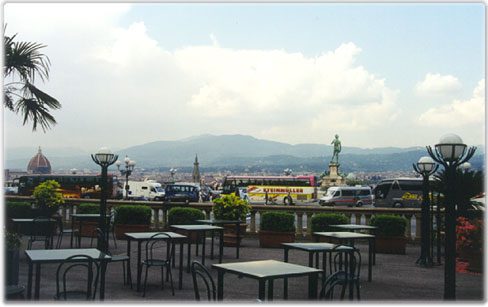 Piazza Michelangelo: Bronze David replica overlooks Firenze |
|
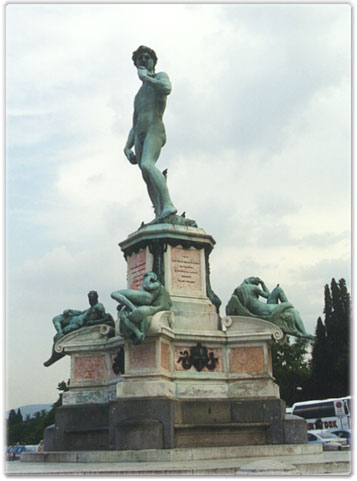 Piazza Michelangelo: David replica 1 |

Piazza della Signoria: David replica 2 and me |
 After
we settled into our room, we were out again, on our favorite mode of transportation.
The city center was within (long) walking distance. We followed the murky
Arno River (like the Tiber in Rome, an ugly, dead waterway) until we got
to the Ponte Vecchio.
My first assignment was to shop for my friend Liz: I was charged with
finding her a pair of gold earrings.
After
we settled into our room, we were out again, on our favorite mode of transportation.
The city center was within (long) walking distance. We followed the murky
Arno River (like the Tiber in Rome, an ugly, dead waterway) until we got
to the Ponte Vecchio.
My first assignment was to shop for my friend Liz: I was charged with
finding her a pair of gold earrings.
The Ponte Vecchio,
the oldest bridge in Firenze (1345), has always been a bridge of shops;
originally butchers and blacksmiths were residents. But, in 1593, they
were kicked out by a Duke because of the smell, and the shops renovated
and leased to goldsmiths. Thus the mecca of gold jewelry today ... my
eyes were aching from the glitter. Almost at the point of total confusion
amidst the gazillion choices, I found earrings that looked right. And
something else. After seeing so many beautiful things, my interest in jewelry was reawakened.
I had had no intention (honest!) of getting something for myself, but
... I did keep a lid on it, just some small earrings.
After seeing so many beautiful things, my interest in jewelry was reawakened.
I had had no intention (honest!) of getting something for myself, but
... I did keep a lid on it, just some small earrings.
Across the river was the Piazza della Signoria, which has an outdoor gallery of famous sculptures: the David (replica 2 above), Ammanati's grandiose Neptune Fountain, and several other statues including the Rape of the Sabine Women by Giambologna.
The Piazza's backdrop is formed by a wall of Palazzo Vecchio, Firenze's town hall since 1322. It looks like a medieval castle and has a beautiful 308-foot-high bell tower.
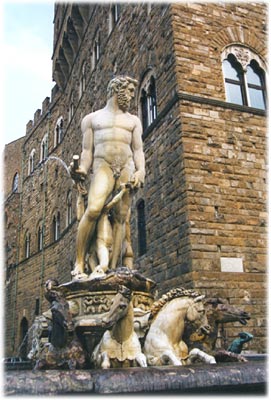 Neptune Fountain |
 Palazzo Vecchio bell tower, from Uffizi corridor |
||
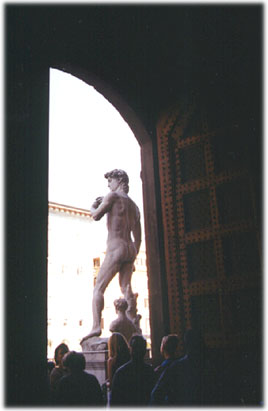 The original David once stood by the Palazzo Vecchio, but was moved indoors in 1873. This replica is now in the same place. |
|||
On our first full
day in Firenze, we took a cab to the Galleria dell'Accademia, home of
Michelangelo's David (1504). My top priority, I think, of the whole trip
was to see him. The line to get in extended down the street, but we were
early and got inside quickly. 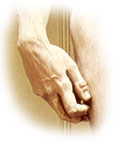 I'll
never forget entering the long, wide corridor of statues and seeing the
David, alone, at the far end, under a specially built dome. It took my
breath away; then brought tears to my eyes. It is that spectacular.
At the time, Giorgio Vasari said it eloquently:
I'll
never forget entering the long, wide corridor of statues and seeing the
David, alone, at the far end, under a specially built dome. It took my
breath away; then brought tears to my eyes. It is that spectacular.
At the time, Giorgio Vasari said it eloquently:
Without any doubt this figure has put in the shade every other statue, ancient or modern, Greek or Roman ... such were the satisfying proportions and beauty of the finished work ... To be sure, anyone who has seen Michelangelo's David has no need to see anything else by any other sculptor, living or dead.
Many of Michelangelo's other great works such as Quattro Prigioni were also in the Galleria. But most of our time was spent walking around, sitting in front of, and staring from a distance at, David. Since photos were not allowed, I've included some views from postcards. [David views]
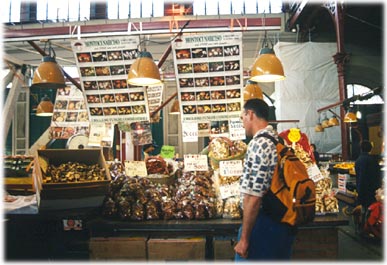 Still
on a high from being with David, we walked to the San Lorenzo area. Every
day, the piazza and streets fill with merchants selling leather goods
— very tempting, with so many beautiful things at good prices. It's
a pleasure just smelling the leather-filled air. There's also a large
two-story cast iron building, Mercato Centrale, full of vendor stalls.
Meat, fish, poultry, etc. are sold on the first level and fruits and vegetables
are upstairs. Peter had a good time hunting for funghi (mushrooms).
Still
on a high from being with David, we walked to the San Lorenzo area. Every
day, the piazza and streets fill with merchants selling leather goods
— very tempting, with so many beautiful things at good prices. It's
a pleasure just smelling the leather-filled air. There's also a large
two-story cast iron building, Mercato Centrale, full of vendor stalls.
Meat, fish, poultry, etc. are sold on the first level and fruits and vegetables
are upstairs. Peter had a good time hunting for funghi (mushrooms).
It was a warm, clear day, and the Piazza del Duomo with its soaring structures were our next destination.
The cathedral, Santa Maria del Fiore, better known as the Duomo, is one of the most magnificent places we'd seen. The facade, a late addition in 1871-87, used the same gorgeous pink, green and white Tuscan marble that Giotto used for his Campanile, designed in 1334, and completed in 1359. The dome itself was the incredible achievement of Brunelleschi — the largest of its time, it took 14 years (1420-34) and was built without scaffolding. It's a stunning architectural work and is probably the most recognizable symbol of Florence.
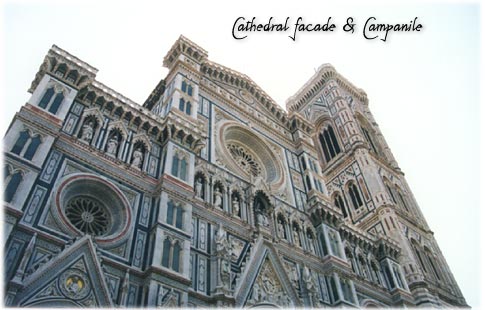 The
Campanile and Baptistry next to the Duomo are spectacular in their own
right. The Baptistry is one of the oldest structures in Firenze, probably
4th century, and has famous doors (15th C) by Ghiberti with panels showing
biblical scenes. Here are a few more views of the Duomo
buildings.
The
Campanile and Baptistry next to the Duomo are spectacular in their own
right. The Baptistry is one of the oldest structures in Firenze, probably
4th century, and has famous doors (15th C) by Ghiberti with panels showing
biblical scenes. Here are a few more views of the Duomo
buildings.
The inside of the cathedral was surprisingly barren compared with the outside, and with others we'd seen (in Rome, Assisi and Siena). I'm not sure why this was, the focus seemed to be mainly on the exteriors. Stay with me a bit longer ... we head up next.
Roma • Roma2 • Roma3 • Vesuvio & Pompei • Sorrento to Amalfi Coast • Capri
Amalfi Coast • Perugia • Siena & Toscana • Firenze • Firenze2
© 2001 CCarnovale Home | Web Design | Graphics | Photos | Travels